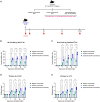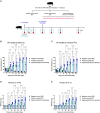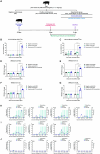Levamisole, as a viral vaccine adjuvant, induces robust host defense through the modulation of innate and adaptive immune responses
- PMID: 39845058
- PMCID: PMC11751227
- DOI: 10.3389/fmicb.2024.1493561
Levamisole, as a viral vaccine adjuvant, induces robust host defense through the modulation of innate and adaptive immune responses
Abstract
Introduction: An effective vaccination policy must be implemented to prevent foot-and-mouth disease (FMD). However, the currently used vaccines for FMD have several limitations, including induction of humoral rather than cellular immune responses.
Methods: To overcome these shortcomings, we assessed the efficacy of levamisole, a small-molecule immunomodulator, as an adjuvant for the FMD vaccine. We conducted in vitro studies using murine peritoneal exudate cells (PECs) and porcine peripheral blood mononuclear cells (PBMCs) and in vivo studies using mice (experimental animals) and pigs (target animals). We evaluated levamisole-mediated modulation of the innate and adaptive immune responses; early, mid-term, and long-term immune-inducing effects; modes of action; and host defense against viral infection.
Results: Levamisole treatment promoted IFNγ secretion in murine PECs and porcine PBMCs. Additionally, it induced robust and long-lasting immune responses by eliciting high antibody titers and high virus-neutralizing antibody titers. By activating downstream signaling pathways of various pattern-recognition receptors, levamisole stimulated the expression of multiple cytokines and costimulatory molecules. Owing to these immunostimulatory effects, levamisole elicited host defense against viral infections in pigs. Our findings demonstrate the potential of levamisole as an immunostimulatory agent.
Discussion: The results also indicate that levamisole, as an adjuvant for animal vaccines, can elicit robust innate and adaptive immune responses, thereby enhancing host defense against viral infections. This study provides a promising approach for the development of improved FMD vaccine strategies in the future.
Keywords: host defense; immunomodulation; innate and adaptive immunity; levamisole; vaccine adjuvant.
Copyright © 2025 Kim, Kwak, Kim, Shin, Ko, Hwang, Park, Kim, Park, Kim and Lee.
Conflict of interest statement
The authors declare that the research was conducted in the absence of any commercial or financial relationships that could be construed as a potential conflict of interest.
Figures







Similar articles
-
Next-generation adjuvant systems containing furfurman drives potent adaptive immunity and host defense as a foot-and-mouth disease vaccine adjuvant.Front Immunol. 2024 Dec 11;15:1491043. doi: 10.3389/fimmu.2024.1491043. eCollection 2024. Front Immunol. 2024. PMID: 39742276 Free PMC article.
-
Inactivated vaccine with glycyrrhizic acid adjuvant elicits potent innate and adaptive immune responses against foot-and-mouth disease.Front Microbiol. 2023 Oct 31;14:1289065. doi: 10.3389/fmicb.2023.1289065. eCollection 2023. Front Microbiol. 2023. PMID: 38029108 Free PMC article.
-
Mincle and STING-Stimulating Adjuvants Elicit Robust Cellular Immunity and Drive Long-Lasting Memory Responses in a Foot-and-Mouth Disease Vaccine.Front Immunol. 2019 Oct 29;10:2509. doi: 10.3389/fimmu.2019.02509. eCollection 2019. Front Immunol. 2019. PMID: 31736952 Free PMC article.
-
Innate and adaptive immune responses in respiratory virus infection: implications for the clinic.Expert Rev Respir Med. 2020 Nov;14(11):1141-1147. doi: 10.1080/17476348.2020.1807945. Epub 2020 Sep 21. Expert Rev Respir Med. 2020. PMID: 32762572 Review.
-
Experimental modulation of IL-1 production and cell surface molecule expression by levamisole.Ann N Y Acad Sci. 1993 Jun 23;685:259-68. doi: 10.1111/j.1749-6632.1993.tb35874.x. Ann N Y Acad Sci. 1993. PMID: 8103313 Review.
References
-
- Arzt J., Baxt B., Grubman M., Jackson T., Juleff N., Rhyan J., et al. . (2011). The pathogenesis of foot-and-mouth disease II: viral pathways in swine, small ruminants, and wildlife; myotropism, chronic syndromes, and molecular virus–host interactions. Transbound. Emerg. Dis. 58, 305–326. doi: 10.1111/j.1865-1682.2011.01236.x, PMID: - DOI - PubMed
LinkOut - more resources
Full Text Sources

